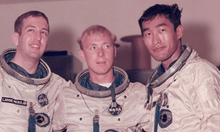John Hirasaki
John Hirasaki (born 1941) is an American mechanical engineer who worked for the United States' National Aeronautics and Space Administration (NASA) during the Apollo 11 mission, the first manned mission to the Moon. In 1969 he – along with Buzz Aldrin, Neil Armstrong, Michael Collins, and William Carpentier – became one of the first five known humans to view lunar rocks inside Earth's atmosphere.
John K. Hirasaki | |
|---|---|
.jpg) Hirasaki in 1969 | |
| Born | 1941 (age 78–79) Vidor, Texas, U.S.[1] |
| Nationality | American |
| Alma mater | Lamar State College of Technology |
| Occupation | Mechanical engineer |
| Employer | NASA |
| Home town | Vidor, Texas, United States |
| Relatives | Kichimatsu Kishi (grandfather) |
Early life and education
Hirasaki was born in Vidor, Texas.[1] He attended Vidor High School and later went on to graduate from Lamar State College of Technology,[2] where he received a Bachelor of Science degree in Mechanical Engineering in 1964.[1][3]
Career
Hirasaki was hired by the Landing and Recovery Division of the Manned Spacecraft Center of NASA in 1966.[4]
Apollo 11

The Apollo 11 mission represented the first contact of humans with a non-Earth surface and concern was expressed by the National Academies of Science that the returning astronauts and spacecraft might inadvertently carry extraterrestrial life which could pose a "catastrophic" risk to humankind.[5] Anxiety was exacerbated by the presence of President of the United States Richard Nixon aboard USS Hornet, the United States Navy aircraft carrier tasked with recovery of the astronauts.[5] To address these issues, a Mobile Quarantine Facility (MQF) was installed aboard the ship in which the returning astronauts, as well as flight surgeon William Carpentier, would be isolated.[5] According to Hirasaki, four NASA engineers responded to a call for volunteers for a technician to be present inside the MQF during the quarantine period for necessary maintenance, and to physically remove the lunar rocks that had been recovered by the mission.[2][6][7][8] Prior to the recovery, the engineers drew straws, Hirasaki drawing the short straw.[8] He spent the next three weeks in quarantine with the astronauts and Carpentier.[8] Hirasaki noted that, prior to the mission, he had read the Michael Crichton book The Andromeda Strain; however, he felt the risks to his personal safety were "very, very minimal."[8]
After removing the recovered lunar rocks to the MQF, Hirasaki opened the containment pouch in which they were stored so that he, Buzz Aldrin, Neil Armstrong, Michael Collins, and William Carpentier could look at them, making him one of the first five known human beings in history to view lunar rocks inside the atmosphere of Earth.[2][6]
In his 1974 autobiography, Carrying the Fire, Michael Collins described Hirasaki as "quiet, flexible, unobtrusive" and said that both he and William Carpentier were "good choices" to join the astronauts in the MQF.[9]
Personal life
Hirasaki's grandfather was the farmer and businessman Kichimatsu Kishi.[4] His uncle, Taro Kishi, was the first Asian-American to attend Texas A&M University and, as a member of that school's football team, the first person of Japanese ancestry to play intercollegiate football in the history of the Southwest Conference.[10][4]
As of 2009, Hirasaki was living in Dickinson, Texas.[6]
References
- "Lunar Luminary – John K. Hirasaki". City of Vidor. July 18, 2019. Archived from the original on 2019-07-20.
- Dwyer, Kevin (July 18, 2004). "In A Confined Space". Beaumont Enterprise. Retrieved October 29, 2017 – via Japanese American Citizens League: Houston Chapter.
- Vitanza, Shelly (July 19, 2019). "Lamar University salutes alumni who put man on the moon". Lamar University.
- Carmichael, Scott (2012). Moon Men Return: USS Hornet and the Recovery of the Apollo 11 Astronauts. Naval Institute Press. ISBN 1612512526 – via Google Books.
- Edwards, Owen (July 2004). "Splendid Isolation". Smithsonian Magazine. Retrieved 29 October 2017.
- Hoover, Will (July 24, 2009). "Historic Moon Journey ended in Islands". Honolulu Advertiser. Retrieved October 29, 2017.
- Jardin, Xeni (July 20, 2016). "Smithsonian launches online Apollo 11 high-res 3D spacecraft model for moon landing's 47th anniversary". Boing Boing. Retrieved October 29, 2017.
- Johnson, Sandra (March 6, 2009). "John K. Hirasaki". NASA Johnson Space Center Oral History Project. NASA. Retrieved October 29, 2017.
- Collins, Michael (2001). Carrying the Fire: An Astronaut's Journey. Rowman & Littlefield. p. 443. ISBN 081541028X.
- "Did you know that..." tamu.edu. Texas A&M University. Retrieved October 29, 2017.
| Wikiquote has quotations related to: John Hirasaki |